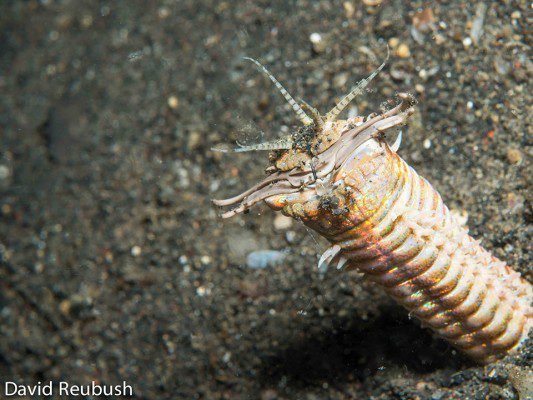
Bobbit worms are known for their impressive size and somewhat fearsome appearance. With their long, segmented bodies reaching up to 10 feet long, it’s easy to see why they capture attention. They have sharp, powerful jaws that snap shut at lightning speed to catch unsuspecting prey. Just like a hidden trapdoor in a forest, Bobbit worms burrow into the ocean floor, waiting patiently for fish and other unsuspecting creatures to come too close. But do they actually pose a danger to humans? Let’s find out together.
What Are Bobbit Worms?
Bobbit worms, scientifically known as *Eunice aphroditois*, belong to the family of polychaete worms. These creatures are typically found in tropical and subtropical ocean waters, often hiding in sand or mud. Their unique ability to camouflage themselves makes them experts in ambush hunting. Picture a predator lying in wait, nearly invisible to its prey until the moment it strikes.
These worms are not just about size; their appearance can be quite striking. Bobbit worms usually have vibrant colors, ranging from greens and purples to blues, which help them blend in with their surroundings. Their long, segmented bodies are equipped with powerful jaws that can extend to grab prey. Imagine a snake, but in worm form—quick, agile, and always ready to pounce!
Are Bobbit Worms Dangerous to Humans?
So, here’s the big question—are Bobbit worms a threat to divers and swimmers? The straightforward answer is: generally, no. Bobbit worms typically don’t seek out humans. They prefer to stay hidden, bobbing quietly in their burrows. However, there are few things that divers should be aware of.
While Bobbit worms aren’t aggressive, they won’t hesitate to defend themselves if they feel threatened. If you accidentally disturb one while swimming or diving, it may bite in self-defense. The bite can be painful and result in some nasty injuries, but it’s not life-threatening. Think of it like surprising a sleeping dog; it might snap at you, but that doesn’t mean it’s out to get you.
The Anatomy of a Bobbit Worm
Understanding the anatomy of a Bobbit worm might help demystify this creature a bit more. Their bodies are long and segmented, with a distinct head featuring two sets of antennae. These help them sense their surroundings. The elongated body is divided into many segments, each equipped with bristles called chaetae, which aid in movement.
The most striking feature of the Bobbit worm is undoubtedly its jaws. These jaws are sharp and can snap shut at an incredible speed, allowing the worm to catch fish and crustaceans with ease. Imagine a pair of scissors that can cut through almost anything—the jaws are that effective! This anatomical feature, however, is primarily used for hunting, not for attacking humans.
How to Stay Safe While Diving or Swimming in Their Habitat
If you’re planning to dive or swim in areas where Bobbit worms might be lurking, it’s smart to take a few precautions. While these creatures aren’t typically looking for trouble, it’s essential to be aware of your surroundings. Here are some tips:
- Don’t Touch: Avoid reaching into crevices or holes in the ocean floor. Bobbit worms can be well-hidden.
- Stay Calm: If you spot a Bobbit worm, don’t panic! Just enjoy the view from a safe distance.
- Wear Protection: Consider wearing gloves or a wetsuit if you’re diving in areas known for these worms.
- Educate Yourself: Understanding marine life is key. The more you know, the safer you’ll feel.
Remember, the ocean is home to countless unique creatures, and most of them are harmless. It’s all about enjoying the beauty and wonder of the underwater world while being mindful of its inhabitants.
Bobbit Worms vs. Other Marine Creatures: A Comparison
It’s always helpful to compare Bobbit worms to other marine creatures to understand their behaviors and risks better. For instance, let’s look at jellyfish. These creatures can deliver painful stings, often leaving swimmers in discomfort. Bobbit worms, on the other hand, are more about stealth and surprise.
Consider sea urchins, which can have sharp spines that pose a risk to divers who accidentally step on them. Bobbit worms, while capable of biting, don’t lethally sting or puncture. So, in the grand scheme of ocean creatures, Bobbit worms aren’t the biggest threat to humans.
Understanding these comparisons can help you see that while the ocean has its dangers, knowing how to respect and navigate them makes all the difference.
The Role of Bobbit Worms in the Ecosystem
Every creature plays a part in the ecosystem, and Bobbit worms are no different. They serve as important predators in their environments, helping to control populations of smaller fish and other marine organisms. By hunting and consuming these creatures, Bobbit worms contribute to the balance of marine life.
Additionally, as Bobbit worms dig burrows in the ocean floor, they help to aerate the sediment. This aeration is crucial for the health of the ocean floor, allowing nutrients to circulate and benefiting other organisms. Think of Bobbit worms as the gardeners of the marine world, ensuring that everything thrives.
By understanding their role in the ecosystem, we can appreciate that Bobbit worms are not just fascinating creatures but also essential to the health of their underwater communities.
In summary, while Bobbit worms may look intimidating with their long bodies and sharp jaws, they generally don’t pose a significant threat to divers or swimmers. They prefer to stay hidden and are more curious than aggressive. That said, respecting their space and being aware of your surroundings is always a smart way to enjoy the ocean safely.
The key takeaway? Bobbit worms are just one of the many wonders of marine life. With a little knowledge and caution, you can explore their habitat without worry. So, the next time you find yourself in the ocean, remember to take a moment to appreciate these unique creatures from a safe distance—it’s all part of the adventure!
